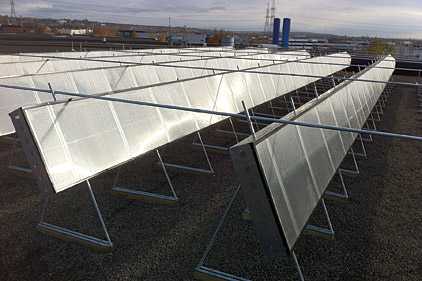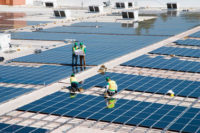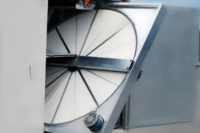
|
| Tax credits are available until Dec. 31, 2016, for multiple renewable technologies that could help increase contractor profitability. |
Not all energy-efficient HVAC equipment qualifies for tax credits, but there are four renewable energy product categories that do — geothermal heat pumps, small wind turbines, solar energy systems, and fuel cells. All four are available for residential applications and though some seem beyond HVAC, they each have the potential to bring new revenue streams to contractors while saving money for homeowners and energy for the planet.
With the tax credits for these four renewable energy product groups, contractors have the potential to increase sales of renewable installations. They also have the opportunity to add new business segments to their company as the demand for renewable increases. The key to capitalizing on these tax credits is to understand them and communicate their benefits to the customer. Overpromising and selling renewable equipment for the sake of tax credits and increased profits is arguably a bad idea. Contractors who are interested in the art of renewable technology and have a desire to fill customer requests, however, can find a beneficial ally in renewable technology tax credits.
Geothermal Heat Pumps
Geothermal tax credits helped drive this product category installation to new heights in the past few years and there is still opportunity to take advantage of these tax credits. The current available tax credit doesn’t expire until Dec. 31, 2016. According to the Energy Star® website, the tax credit is for 30 percent of the cost with no upper limit. Installations that qualify include existing homes, new construction, principal residences, and second homes. Rentals are not included. The equipment used must meet the requirements of the Energy Star program that are in effect at the time of the expenditure. The tax credit includes the equipment and installation.
Small Wind Turbines
Residential small wind turbines qualify for the same 30 percent of cost with no upper limit tax credit and doesn’t expire until Dec. 31, 2016. Unlike a windmill that pumps water or does work directly from the wind, a wind turbine produces electricity. Existing homes, new construction, principal residences, and second homes qualify for this tax credit, but rentals are not included. The wind turbine unit must have a nameplate capacity of no more than 100 kW and the tax credit includes installation costs.
A wind turbine may sound like a strange design specification to be made by HVAC contractors, but David Sprague and Brian Nelson, principals of Nelson Mechanical Design Inc. in Edgartown, Mass., have been providing high-end green solutions to their customers in Martha’s Vineyard and Nantucket for many years. The contractor has received multiple awards including one for the West Tisbury home of Alexander Boyle, which won the Greenest Design in America award from the Green Mechanical Council in 2009. The install called not only for a geothermal system, but also had an Endurance S-250 wind turbine. This 10-kW turbine provided enough power to supply the home electricity demands, including the heat pump. The excess energy generated was sold back through a co-op to the energy grid. This company has based all of its HVAC business tactics around innovative renewable design and equipment. They have found it to be a successful and worthwhile endeavor for themselves and their customers.
Solar Energy Systems
There are two forms of harnessing the power of the sun that qualify for tax credits — solar water heaters and solar panels. Typically described by the type of collector and the circulation system, solar water heaters have a collector, a storage tank, and use the sun’s thermal energy to heat water. The tax credit, which is 30 percent of cost, including installation, has no upper limit and doesn’t expire until Dec. 31, 2016. It applies to existing homes, new construction, principal residents, and second homes. Rentals do not qualify, and neither do expenses for swimming pools or hot tubs. It is mandatory that the water from the solar water heater be used within the dwelling in order to qualify for the tax credit.
Solar panels, also known as photovoltaic systems are solar cells that capture light energy from the sun and convert it directly into electricity. These systems qualify under much the same regulations as listed for solar water heaters. One requirement specific to photovoltaic systems is that the systems must provide electricity for the residence and it must meet applicable fire and electrical code requirements.
Fuel Cells
The final of the four tax-credit-eligible renewable products is fuel cell technology. Fuel cells include the residential fuel cell and microturbine systems. The tax credit expires Dec. 31, 2016, and covers existing homes and new construction; but it does not cover rentals or secondary homes. The install must be in the current principal residence to qualify. Thirty percent of the cost, including installation, is covered up to $500 per 0.5 kW of power capacity. The cell must have at least 30 percent efficiency and must have a capacity of at least 0.5 kW.
Although not often heard of in the HVAC industry, fuel cell applications are growing. According to a report from Pike Research, “The stationary fuel cell market experienced 60 percent year-over-year growth in unit shipments between 2009 and 2010, and the firm forecasts that sales volumes will continue to expand at an impressive pace over the next several years, surpassing 1.2 million units annually by 2017.”
More common in commercial applications, there are residential fuel cells that stand about the size of an a/c unit and provide primary or backup hydrogen power. They are included in the tax credits.
As the popularity of this power source increases and the technology continues to improve, contractors may find that offering fuel cells could be a lucrative, renewable opportunity for their customers and their companies.
Study the Fine Print
There are many opportunities in renewable technology, but if contractors are considering selling new products with new customer initiatives, it is imperative that they study and understand the fine print. This article should get some residential contractors started, but a complete knowledge of the tax credits and their rules will provide a solid foundation for a renewable future with contractors’ customers.
For more information, visit www.energystar.gov and search “renewable tax credits” or go to http://1.usa.gov/NjFnrE.
Publication date: 8/27/2012









